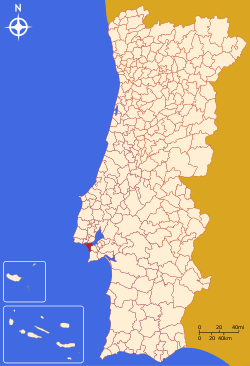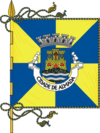Almada
| Almada | |||
|---|---|---|---|
| Municipality | |||
|
Aereal view of Almada with the famous Sanctuary of Christ the King | |||
| |||
 | |||
| Coordinates: 38°40′49″N 9°9′30″W / 38.68028°N 9.15833°WCoordinates: 38°40′49″N 9°9′30″W / 38.68028°N 9.15833°W | |||
| Country |
| ||
| Region | Lisbon | ||
| Subregion | Península de Setúbal | ||
| Metropolitan area | Lisbon | ||
| District | Setúbal | ||
| Parishes | 5 | ||
| Government | |||
| • President | Joaquim Estêvão Miguel Judas (CDU) | ||
| Area | |||
| • Total | 70.21 km2 (27.11 sq mi) | ||
| Elevation | 33 m (108 ft) | ||
| Lowest elevation | 0 m (0 ft) | ||
| Population (2011) | |||
| • Total | 174,030 | ||
| • Density | 2,500/km2 (6,400/sq mi) | ||
| Time zone | WET/WEST (UTC+0/+1) | ||
| Postal code | 2805 | ||
| Area code | 21 | ||
| Patron | São João Baptista | ||
| Website | http://www.m-almada.pt | ||
Almada (Portuguese pronunciation: [ɐɫˈmaðɐ]) is a city and a municipality in Portugal, located on the southern margin of the Tagus River. The population in 2011 was 174,030,[1] in an area of 70.21 km².[2] The urbanized center had a population of 101,500 in 2001.[3]
History
Human presence in the area of Almada dates to the end of the Neolithic period about 5000 years ago; archeological excavations performed in the municipality suggest that non-sedentary nomadic tribes may have occupied this location sporadically. The gradual development of settlement here made its greatest advance with the coming of Islamic civilization, when Muslims constructed a fort at Almada to defend and monitor the entrance to the Tagus River. Lying across the river from Lisbon, the area of Almada was a crossroads for a succession of various peoples who traded along the Tagus, including Phoenicians, Romans and Moors.
As one of the principal Arab military bases along the southern margin of the Tagus, Almada was conquered by the Christian forces of Afonso I with the aid of English Crusaders in 1147. Alongside these Christians there lived many free Moors and Jews, under the royal protection guaranteed them by Afonso I in the charter of 1170 (which applied to all the former Moorish strongholds at Lisbon, Almada, Palmela and Alcácer).
Almada received a foral from King Sancho I in 1190, although it came at a price: Miramolim Jacub-Abu-Jassuf, son of the Moorish leader who had laid siege to Santarém in 1171, was angered by the Christian victories and gathered a large army. He boldly attacked in the north, conquering Alcácer do Sal and Silves, while forcing the residents of Almada, Palmela and other towns along the Tagus into hiding.[4] It would be some time after the death of Sancho before this region would be restored to Portuguese control.
When this event occurred with the success of the Reconquista in driving the Muslims out, the Order of Santiago, a donatorio of Almada after 28 October 1186, had an important role in the territory (especially between the Tagus and Sado Rivers). In this role, it facilitated the repopulation of acquired territories and was the beneficiary of the various local economies.
Geography
.jpg)
Although small in area, Almada has a high population density. It is bounded to the southeast by Seixal, to the south by Sesimbra, to the west by the Atlantic Ocean and to the north and northeast by the Tagus River. At Cacilhas, its main port, ferry boats transport visitors and local residents across to Lisbon daily, while the 25 de Abril Bridge, which spans the Tagus, is traversed by rail, commercial and personal vehicles daily. Almada is considered a transportation hub and a fast-growing suburb; its coast has several sandy beaches and panoramic vistas.
Located in the district of Setúbal, the municipality includes two cities, Almada and Costa da Caparica, and is divided into five civil parishes:[5]
- Almada, Cova da Piedade, Pragal e Cacilhas
- Caparica e Trafaria
- Charneca de Caparica e Sobreda
- Costa da Caparica
- Laranjeiro e Feijó
International relations
Almada is twinned with:
Transportation
The 25 de Abril Bridge links Lisbon and Almada, which are on opposite sides of the Tagus river. The municipality is being served by a light-rail transit system, the Metro Transportes do Sul, which is continually expanding, linking it to the suburban rail system serving Greater Lisbon and the municipality of Seixal.
Sanctuary of Christ the King
Notable citizens
- Anabela Braz Pires, better known as Anabela, (born 22 September 1976) is a singer and musical theatre actress;
- Da Weasel, formed in 1993, is a hip-hop band;
- Ava Inferi, is a Doom Metal Band;
- Luís Filipe Madeira Caeiro Figo, OIH, better known as Figo, (born 4 November 1972), is a former football player;
- Telma Monteiro (born 27 December 1985) is a world champion judoka;
- Xutos e Pontapes, formed in 1978, is a Rock band;
- UHF a rock band formed in the late 1970s in Almada;
- Sara Tavares born in 1978 became an important singer in the 90s;
References
- Notes
- ↑ Instituto Nacional de Estatística
- ↑ Direção-Geral do Território
- ↑ City parishes: Almada, Cova da Piedade, Pragal e Cacilhas and Laranjeiro e Feijó. UMA POPULAÇÃO QUE SE URBANIZA, Uma avaliação recente - Cidades, 2004 Nuno Pires Soares, Instituto Geográfico Português (Geographic Institute of Portugal)
- ↑ John Felix Pereira (2009), p.31
- ↑ Diário da República. "Law nr. 11-A/2013, page 552 10" (pdf) (in Portuguese). Retrieved 8 July 2014.
- Sources
- Pereira, John Felix (2009). Abridgement of the History of Portugal. Charleston, South Carolina: BiblioLife LLC. ISBN 978-1-110-33521-3.
External links
- Portal de Almada - Eventos, Classificados, Notícias, Empresas
- Photos from Almada
- Almada Atlético Clube
| ||||||||
| ||||||


